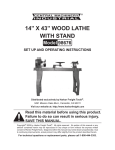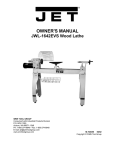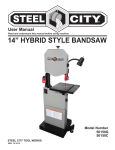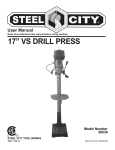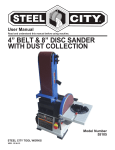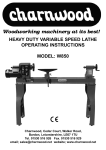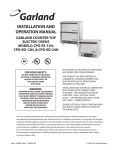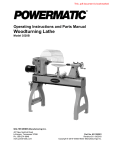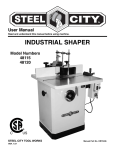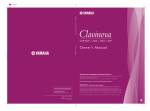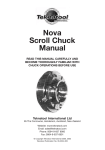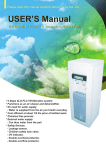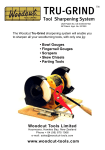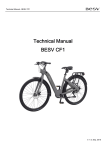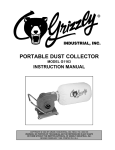Download GRANITE MIDI LATHE - Steel City Tool Works
Transcript
R GRANITE MIDI LATHE Model Number 60100G&60155G (Variable Speed) Model Number 60170G&60150G (5-Speed) STEEL CITY TOOL WORKS VER. 04.11 Manual Part No. OR71666 R d d d d d 2 TABLE OF CONTENTS INTRODUCTION SECTION 1 Warranty .................................................................................................................................................4 SECTION 2 Product Specifications ............................................................................................................................7 SECTION 3 Accessories and Attachments ................................................................................................................8 SECTION 4 Definition of Terms ..................................................................................................................................8 SECTION 5 Feature Identification ..............................................................................................................................9 SECTION 6 General Safety ......................................................................................................................................11 SECTION 7 Product Safety ......................................................................................................................................13 SECTION 8 Electrical Requirements........................................................................................................................15 SECTION 9 Unpacking & Inventory..........................................................................................................................17 SECTION 10 Assembly ..............................................................................................................................................19 SECTION 11 Adjustments ..........................................................................................................................................20 SECTION 12 Operations ............................................................................................................................................25 SECTION 13 Maintenance .........................................................................................................................................26 SECTION 14 Troubleshooting ....................................................................................................................................28 SECTION 15 Parts List...............................................................................................................................................30 INTRODUCTION This user manual is intended for use by anyone working with this machine. It should be kept available for immediate reference so that all operations can be performed with maximum efficiency and safety. Do not attempt to perform maintenance or operate this machine until you have read and understand the information contained in this manual. The drawings, illustrations, photographs, and specifications in this user manual represent your machine at time of print. However, changes may be made to your machine or this manual at any time with no obligation to Steel City Tool Works. 3 WARRANTY 2 YEAR LIMITED WARRANTY Steel City Tool Works, LLC (SCTW) warrants this SCTW machinery to be free of defects in workmanship and materials for a period of 2 years from the date of the original retail purchase by the original owner for domestic use. Granite components are warranted for 2 years based on normal use and is void if non SCTW accessories are used that cause the break or chip. Customer must advise SCTW within 30 days for any damage or defect found upon receipt of the product to qualify for the warranty on granite. The warranty does not cover any product used for professional or commercial production purpose nor for industrial or educational applications. Such cases are covered by our 1 year Limited Warranty with the Conditions and Exceptions listed below. Conditions and exception: Warranty applies to the original buyer only and may not be transferred. Original proof of purchase is required. Warranty does not include failures, breakage or defects deemed after inspection by an Authorized Service Center, (ASC) or agent of, have been directly or indirectly caused by or resulting from improper use, lack of or improper maintenance, misuse or abuse, negligence, accidents, damage in handling or transport, or normal wear and tear of any part or component. Additionally, warranty is void if repairs or alterations are made to the machine by an unauthorized service center without the direct consent of SCTW Consumables such as blades, knives, bits and sandpaper are not covered. Wear items such as drive belt, bearings, switch, are covered for 1 year. To file a claim of warranty or to find a service center, call toll free 877-724-8665 or email [email protected] and you must be able to present the original or photo copy of the sales receipt including the serial number from the machine and/or carton. SCTW will inspect, repair or replace, at its expense and its option, any part that has proven to be defective in workmanship or material, provided that the customer returns the product prepaid to a designated ASC and provides SCTW with a reasonable opportunity to verify the alleged defect by inspection. SCTW will return the product or replacement at our expense unless it is determined by us that there is no defect or that the defect resulted from causes not within the scope of our warranty in which case we will, at your direction, dispose of or return the product. In the event you choose to have the product returned, you will be responsible for the handling and shipping costs of the return. SCTW furnishes the above warranties in lieu of all other warranties, express or implied. SCTW shall not be liable for any special, indirect, incidental, punitive or consequential damages, including without limitation loss of profits arising from or related to the warranty, the breach of any agreement or warranty, or the operation or use of its machinery, including without limitation damages arising from damage to fixtures, tools, equipment, parts or materials, direct or indirect loss caused by and other part, loss of revenue or profits, financing or interest charges, and claims by and third person, whether or not notice of such possible damages has been given to SCTW. Damages or any kind for any delay by or failure of SCTW to perform its obligations under this agreement or claims made a subject of a legal proceeding against SCTW more than one (1) year after such cause of action first arose. The validity, construction and performance of this Warranty and any sale of machinery by SCTW shall be governed by the law of the Commonwealth of Pennsylvania, without regard to conflicts of law’s provisions of any jurisdiction. Any action related in any way to any alleged or actual offer, acceptance or sale by SCTW or any claim related to the performance of and agreement including without limitation this Warranty, shall take place in the federal or state courts in Allegheny County, Pennsylvania. Warranty registration card must be submitted to SCTW for purpose of proof within 90 days of purchase with a copy of the sales receipt. Failure to do so will, revert the 2 year warranty to 1 year as in the terms stated above. This registration is also needed to facilitate contact in case of a safety recall. This warranty gives you specific legal rights and you may have other rights which vary in certain States or Provinces. Note to user This instruction manual is meant to serve as a guide only. Specification and references are subject to change without prior notice. Check the website www.steelcitytoolworks.com for updated manuals with reference to the VER# located on the front page. LIMITED WARRANTY – ACCU-SHOP line of bench top tools Steel City Tool Works, LLC (SCTW) warrants this SCTW ACCU-SHOP machinery to be free of defects in workmanship and materials for a period of 2 years from the date of the original retail purchase by the original owner for domestic use. Consumables such as blades, knives, bits and sandpaper are not covered. Wear items such as drive belt, bearings, switch, are covered for 1 year. The warranty does not cover any product used for professional or commercial production purpose nor for industrial or educational applications. Such cases are covered by our 30 days Limited Warranty with the Conditions and Exceptions listed previously. 4 WARRANTY CARD Name ________________________________________________ Street _______________________________________________ Apt. No. ______________________________________________ City _________________________ State ______ Zip __________ Phone Number_________________________________________ E-Mail ________________________________________________ The following information is given on a voluntary basis and is strictly confidential. 2. Where did you purchase your STEEL CITY machine? Store: ____________________________________________ City:______________________________________________ CUT HERE 3. 4. 5. Which of the following magazines do you subscribe to? ___ American Woodworker ___ American How-To ___ Family Handyman ___ Fine Homebuilding ___ Journal of Light Construction ___ Popular Mechanics ___ Fine Woodworking ___ Old House Journal ___ Popular Science ___ Popular Woodworking ___ Today’s Homeowner ___ WOOD ___ WOODEN Boat ___ Woodsmith ___ Woodcraft ___ Woodshop News ___ Woodwork ___ Woodworker ___ Workbench ___ Woodworker’s Journal Other_________________ 6. 7. ___ Air Compressor ___ Drill Press ___ Dust Collection ___ Band Saw ___ Drum Sander ___ Horizontal Boring Machine ___ ___ ___ ___ ___ ___ ___ ___ Jointer Mortiser Planer Radial Arm Saw Lathe Panel Saw Power Feeder Shaper ___ Belt Sander ___ Drill Press ___ Belt / Disc Sander ___ Band Saw ___ Grinder ___ Mini Lathe ___ Mini Jointer ___ Scroll Saw ___ Spindle / Belt Sander Other______________________ 12. Which portable / hand held power tools do you own? Check all that apply. ___ Belt Sander ___ Biscuit Jointer ___ Dust Collector ___ Circular Saw ___ Detail Sander ___ Miter Saw ___ Drill / Driver ___ Orbital Sander ___ Palm Sander ___ Saber Saw ___ Portable Thickness Planer ___ Reciprocating Saw ___ Router Other_______________________ 13. What machines / accessories would you like to see added to the STEEL CITY line? ____________________________________________________ Which of the following woodworking / remodeling shows do you watch? ___ Backyard America ___ The American Woodworker ___ Home Time ___ The New Yankee Workshop ___ This Old House ___ Woodwright’s Shop Other__________________________________________ ____________________________________________________ 14. What new accessories would you like to see added? ____________________________________________________ ____________________________________________________ What is your annual household income? ___ $20,000 to $29,999 ___ $30,000 to $39,999 ___ $40,000 to $49,999 ___ $60,000 to $69,999 ___ $80,000 to $89,999 How many Steel City machines do you own? _____________ 11. Which benchtop tools do you own? Check all that apply. ___ Friend Other_______________________ ––– Cabinetmaker 9. ___ Spindle Sander ___ Table Saw ___ Vacuum Veneer Press ___ Wide Belt Sander Other____________________________________________ How did you first learn of Steel City Tool Works? ___ Advertisement ___ Mail Order Catalog ___ Web Site ___ Local Store How would you rank your woodworking skills? ___ Simple ___ Intermediate ___ Advance ___ Master Craftsman 10. What stationary woodworking tools do you own? Check all that apply. Product Description:_____________________________________ Model No.: ___________________________________________ Serial No. _____________________________________________ 1. 8. 15. Do you think your purchase represents good value? ___Yes ___ No ___ $50,000 to $59,999 ___ 70,000 to $79,999 ___ $90,000 + 16. Would you recommend STEEL CITY products to a friend? ___ Yes ___ No What is your age group? ___ 20 to 29 years ___ 30 to 39 years ___ 40 to 49 years ___ 60 to 69 years ___ 50 to 59 years ___ 70 + years 17. Comments: ____________________________________________________ ____________________________________________________ ____________________________________________________ ____________________________________________________ ____________________________________________________ How long have you been a woodworker? ___ 0 to 2 years ___ 2 to 8 years ___ 8 to 20 years ___ over 20 years 5 FOLD ON DOTTED LINE PLACE STAMP HER E SteelCityToolWorks #4 Northpoint Court Bolingbrook, IL 60440 FOLD ON DOTTED LINE 6 60100G&60155G Mini Lathe MOTOR 60170G&60150G Mini Lathe Variable Speed 5-Speed Continuous Duty HP 1/2 HP 1/2 HP Amps 3 5.6 Voltage 115V DC 115VAC Phase Single Single Hertz 60 Hz 60 Hz RPM 500-3800 1725 Swing Over Bed 12” 12” Swing Over Tool Rest Base 9-1/4” 9-1/4” Working Distance Between Centers 27”(15” for 60155G) 27” (15” for 60150G) SPECIFICATIONS Range of Speeds (RPM) 500-1350, 1400-3800 500, 1300, 2100, 2750, 3600 Number of Speeds N/A 5 Hole Through Spindle 3/8” 3/8” Headstock Spindle Taper #2 MT #2 MT Tailstock Spindle Taper #2 MT #2 MT Hole Through Tailstock 3/8” 3/8” Toolrest Length 6” 6” PRODUCT DIMENSIONS Length 44”(32” for 60155G) 44” (32” for 60150G) Width 10” 10” Height 20-1/2” 20-1/2” Net Weight 154 lbs.(121lbs for 60155G) 158 lbs.(127lbs for 60150G) SHIPPING DIMENSIONS Carton Type Length Wooden Crate 45-1/2” (33-1/2” for 60155G) Wooden Crate 45-1/2” (33-1/2” for 60150G) Width 13” 13” Height 24-1/2” 24-1/2” Gross Weight 187 lbs.(158lbs for 60155G) 7 192 lbs.(161lbs for 60150G) ACCESSORIES AND ATTACHMENTS There are a variety of accessories available for your Steel City Product. For more information on any accessories associated with this and other machines, please contact your nearest Steel City distributor, or visit our website at: www.steelcitytoolworks.com. DEFINITION OF TERMS Banjo - The part on the lathe which slides along the bed and supports the tool rest. Headstock - The assembly fixed on the left-hand end of the bed of the lathe which provides the drive for the workpiece. Bed - The horizontal part of the lathe which connects the headstock and tailstock. Tailstock - The movable assembly to the right of the headstock which slides along the bed. Chisel - A woodturning tool which is ground with a bevel. Tool rest - Adjustable part of the lathe which fits into the banjo and supports the turning tool while the work is in progress. Chuck - A device which holds the workpiece on the lathe. Faceplate - Fastens to the headstock and is used for face turning operations such as making a bowl. 8 Model Number 60100G&60155G (Variable Speed) M B F N C E D O K A J H L I A) Headstock B) Variable Speed Switch C) Faceplate D) Drive center spindle E) Tool rest F) Tailstock spindle with ball bearing live center G) Handwheel H) Banjo lock handle I) Motor plate lever J) Banjo K) Tool rest lock handle L) Motor plate locking handle M) ON/OFF Switch N) Tailstock O) Bed 9 G Y Z X Model Number 60170G&60150G (5-Speed) AA W U V P R CC S BB Q Z) Headstock Y) ON/OFF switch X) Faceplate W) Drive center spindle V) Tool rest U) Tailstock spindle with ball bearing live center T) Handwheel S) Banjo lock handle R) Banjo Q) Motor plate lever P) Tool rest lock handle AA) Tailstock BB) Bed CC) Motor plate locking handle 10 T GENERAL SAFETY ! ! WARNING WARNING TO AVOID serious injury and damage to the machine, read and follow all Safety and Operating Instructions before assembling and operating this machine. This manual is not totally comprehensive. It does not and can not convey every possible safety and operational problem which may arise while using this machine. The manual will cover many of the basic and specific safety procedures needed in an industrial environment. Exposure to the dust created by power sanding, sawing, grinding, drilling and other construction activities may cause serious and permanent respiratory or other injury, including silicosis (a serious lung disease), cancer, and death. Avoid breathing the dust, and avoid prolonged contact with dust. The dust may contain chemicals known to the State of California to cause cancer, birth defects or other reproductive harm. All federal and state laws and any regulations having jurisdiction covering the safety requirements for use of this machine take precedence over the statements in this manual. Users of this machine must adhere to all such regulations. Some examples of these chemicals are: • Lead from lead-based paints. • Crystalline silica from bricks, cement and other masonry products. • Arsenic and chromium from chemically-treated lumber. Below is a list of symbols that are used to attract your attention to possible dangerous conditions. ! This is the safety alert symbol. It is used to alert you to potential personal injury hazards. Obey all safety messages that follow this symbol to avoid possible injury or death. ! Always operate tool in well ventilated area and provide for proper dust removal. Use a dust collection system along with an air filtration system whenever possible. Always use properly fitting NIOSH/OSHA approved respiratory protection appropriate for the dust exposure, and wash exposed areas with soap and water. DANGER Indicates an imminently hazardous situation which, if not avoided, WILL result in death or serious injury. ! 1. To avoid serious injury and damage to the machine, read the entire User Manual before assembly and operation of this machine. WARNING Indicates a potentially hazardous situation which, if not avoided, COULD result in death or serious injury. ! CAUTION ! WARNING Indicates a potentially hazardous situation, if not avoided, MAY result in minor or moderate injury. It may also be used to alert against unsafe practices. 2. ALWAYS wear eye protection. Any machine can throw debris into the eyes during operations, which could cause severe and permanent eye damage. Everyday eyeglasses are NOT safety glasses. ALWAYS wear Safety Goggles (that comply with ANSI standard Z87.1) when operating power tools. CAUTION CAUTION used without the safety alert symbol indicates a potentially hazardous situation which, if not avoided, may result in property damage. NOTICE This symbol is used to alert the user to useful information about proper operation of the machine. 11 ! 11. DO NOT FORCE the machine to perform an operation for which it was not designed. It will do a safer and higher quality job by only performing operations for which the machine was intended. WARNING 12. DO NOT stand on a machine. Serious injury could result if it tips over or you accidentally contact any moving part. 3. ALWAYS wear hearing protection. Plain cotton is not an acceptable protective device. Hearing equipment should comply with ANSI S3.19 Standards. ! 13. DO NOT store anything above or near the machine. 14. DO NOT operate any machine or tool if under the influence of drugs, alcohol, or medication. WARNING 15. EACH AND EVERY time, check for damaged parts prior to using any machine. Carefully check all guards to see that they operate properly, are not damaged, and perform their intended functions. Check for alignment, binding or breakage of all moving parts. Any guard or other part that is damaged should be immediately repaired or replaced. 4. ALWAYS wear a NIOSH/OSHA approved dust mask to prevent inhaling dangerous dust or airborne particles. 16. Ground all machines. If any machine is supplied with a 3-prong plug, it must be plugged into a 3contact electrical receptacle. The third prong is used to ground the tool and provide protection against accidental electric shock. DO NOT remove the third prong. 5. ALWAYS keep the work area clean, well lit, and organized. DO NOT work in an area that has slippery floor surfaces from debris, grease, and wax. 6. ALWAYS unplug the machine from the electrical receptacle when making adjustments, changing parts or performing any maintenance. 17. Keep visitors and children away from any machine. DO NOT permit people to be in the immediate work area, especially when the machine is operating. 7. AVOID ACCIDENTAL STARTING. Make sure that the power switch is in the “OFF” position before plugging in the power cord to the electrical receptacle. ! 18. KEEP protective guards in place and in working order. 19. MAINTAIN your balance. DO NOT extend yourself over the tool. Wear oil resistant rubber soled shoes. Keep floor clear of debris, grease, and wax. WARNING 20. MAINTAIN all machines with care. ALWAYS KEEP machine clean and in good working order. KEEP all blades and tool bits sharp. 8. AVOID a dangerous working environment. DO NOT use electrical tools in a damp environment or expose them to rain or moisture. ! 21. NEVER leave a machine running, unattended. Turn the power switch to the OFF position. DO NOT leave the machine until it has come to a complete stop. 22. REMOVE ALL MAINTENANCE TOOLS from the immediate area prior to turning the machine ON. WARNING 23. SECURE all work. When it is possible, use clamps or jigs to secure the workpiece. This is safer than attempting to hold the workpiece with your hands. 9. CHILDPROOF THE WORKSHOP AREA by removing switch keys, unplugging tools from the electrical receptacles, and using padlocks. 24. STAY ALERT, watch what you are doing, and use common sense when operating any machine. DO NOT operate any machine tool while tired or under the influence of drugs, alcohol, or medication. A moment of inattention while operating power tools may result in serious personal injury. 10. DO NOT use electrical tools in the presence of flammable liquids or gasses. 12 25. USE ONLY recommended accessories. Use of incorrect or improper accessories could cause serious injury to the operator and cause damage to the machine. If in doubt, DO NOT use it. ! 26. Wear proper clothing, DO NOT wear loose clothing, gloves, neckties, or jewelry. These items can get caught in the machine during operations and pull the operator into the moving parts. Users must wear a protective cover on their hair, if the hair is long, to prevent it from contacting any moving parts. WARNING 4. TO REDUCE the risk of electrical shock. DO NOT use this machine outdoors. DO NOT expose to rain or moisture. Store indoors in a dry area. 27. SAVE these instructions and refer to them frequently and use them to instruct other users. 5. STOP using this machine, if at any time you experience difficulties in performing any operation. Contact your supervisor, instructor or machine service center immediately. 28. Information regarding the safe and proper operation of this tool is also available from the following sources: Power Tool Institute 1300 Summer Avenue Cleveland, OH 44115-2851 www.powertoolinstitute.org 6. Safety decals are on this machine to warn and direct you to how to protect yourself or visitors from personal injury. These decals MUST be maintained so that they are legible. REPLACE decals that are not legible. National Safety Council 1121 Spring Lake Drive Itasca, IL 60143-3201 7. DO NOT leave the unit plugged into the electrical outlet. Unplug the unit from the outlet when not in use and before servicing, performing maintenance tasks, or cleaning. American National Standards Institute 25 West 43rd Street, 4th floor New York, NY 10036 www.ansi.org 8. ALWAYS turn the power switch “OFF” before unplugging the midi lathe. ANSI 01.1 Safety Requirements for Woodworking Machines, and the U.S. Department of Labor regulations www.osha.gov ! PRODUCT SAFETY WARNING 9. DO NOT handle the plug or midi lathe with wet hands. 1. Serious personal injury may occur if normal safety precautions are overlooked or ignored. Accidents are frequently caused by lack of familiarity or failure to pay attention. Obtain advice from supervisor, instructor, or another qualified individual who is familiar with this machine and its operations. 10. USE accessories only recommended by Steel City. 11. DO NOT pull the midi lathe by the power cord. NEVER allow the power cord to come in contact with sharp edges, hot surfaces, oil or grease. 2. Every work area is different. Always consider safety first, as it applies to your work area. Use this machine with respect and caution. Failure to do so could result in serious personal injury and damage to the machine. 12. DO NOT unplug the midi lathe by pulling on the power cord. ALWAYS grasp the plug, not the cord. 13. REPLACE a damaged cord immediately. DO NOT use a damaged cord or plug. If the midi lathe is not operating properly, or has been damaged, left outdoors or has been in contact with water. 3. Prevent electrical shock. Follow all electrical and safety codes, including the National Electrical Code (NEC) and the Occupational Safety and Health Regulations (OSHA). All electrical connections and wiring should be made by qualified personnel only. 14. DO NOT use the midi lathe as a toy. DO NOT use near or around children. 13 15. ALWAYS rotate the workpiece by hand after installing on the faceplate. 28. ALWAYS use safety glasses. Also use face or dust masks if the cutting operation is dusty. Everyday eyeglasses only have impact resistant lenses, they are NOT safety glasses. 16. DO NOT mount a split workpiece or one containing a knot. 29. MAINTAIN tools with care. Keep tools sharp and clean for best and safest performance. Follow instructions for lubricating and changing accessories. 17. ALWAYS use the lowest speed when starting a new workpiece. 18. KEEP guards in place and in working order. 30. REDUCE the risk of unintentional starting. Make sure the switch is in the OFF position before plugging in the machine. 19. REMOVE adjusting keys and wrenches. Form the habit of checking to see that keys and adjusting wrenches are removed from the tool before turning it on. 31. USE recommended accessories. Consult the owner’s manual for recommended accessories. The use of improper accessories may cause a risk of injury. 20. KEEP the work area clean. Cluttered areas and benches invite accidents. 21. DO NOT use in a dangerous environment. Don’t use power tools in damp or wet locations, or expose them to rain. Keep work area well lighted. 32. CHECK damaged parts. Before further use of the tool, a guard or other part that is damaged should be carefully checked to determine that it will operate properly and perform its intended function. Check for alignment of moving parts, binding of moving parts, breakage of parts, mounting, and any other conditions that may affect its operation. A guard or other part that is damaged should be properly repaired or replaced. 22. KEEP children away. All visitors should be kept a safe distance from the work area. 23. MAKE the workshop childproof with padlocks, master switches, or by removing starter keys. 24. DO NOT force the tool. It will do the job better and safer at the rate for which it was designed. 33. DIRECTION OF FEED. Feed work into a blade or cutter only against the direction of rotation of the blade or cutter. 25. WEAR proper apparel. Do not wear loose clothing, gloves, neckties, rings, bracelets, or other jewelry which may get caught in moving parts. Nonslip footwear is recommended. Wear protective hair covering to contain long hair. 34. GIVE your work undivided attention. Looking around, carrying on a conversation and “horse-play” are careless acts that can result in serious injury. 35. TURN OFF the tool and disconnect from power before cleaning. Use a brush or compressed air to remove chips or debris - do not use your hands. 26. DO NOT overreach. Keep proper footing and balance at all times. 27. USE the proper extension cord. Make sure your extension cord is in good condition. When using an extension cord, be sure to use one heavy enough to carry the current your product will draw. Anundersized cord will cause a drop in the line voltage resulting in loss of power and overheating. 36 . NEVER leave the tool running unattended. Turn the power off and do not leave the tool until it comes to a complete stop. 14 ELECTRICAL REQUIREMENTS ! TO REDUCE the risk of electrical shock, DO NOT use machine outdoors. DO NOT expose to rain. Store indoors in a dry area. WARNING TO PREVENT electrical shock, follow all electrical and safety codes, including the National Electrical Code (NEC) and the Occupational Safety and Health Regulations (OSHA). All electrical connections and wiring should be made by qualified personnel only. DO NOT connect the machine to the power source before you have completed the set up process. DO NOT connect the machine to the power source until instructed to do so. The motor in this machine is designed to run at 115V. GROUNDING INSTRUCTIONS ! PLUGS/RECEPTACLES WARNING ! WARNING This machine MUST BE GROUNDED while in use to protect the operator from electric shock. • Electrocution or fire could result if this machine is not grounded properly or if the electrical configuration does not comply with local and state electrical codes. In the event of a malfunction or breakdown, GROUNDING provides the path of least resistance for electric current and reduces the risk of electric shock. This machine is equipped with an electric cord that has an equipment-grounding conductor and a grounding plug. The plug MUST be plugged into a matching electrical receptacle that is properly installed and grounded in accordance with ALL local codes and ordinances. • MAKE CERTAIN the machine is disconnected from power source before starting any electrica| work. • MAKE SURE the circuit breaker does not exceed the rating of the plug and receptacle. If a plug is provided with your machine DO NOT modify the plug. If it will not fit your electrical receptacle, have a qualified electrician install the proper connections to meet all electrical codes local and state. All connections must also adhere to all of OSHA mandates. The motor supplied with your machine is a 115 volt motor. It is shipped wired for 115 volt application. Never connect the green or ground wire to a live terminal. This tool is intended for use on a circuit that has an electrical receptacle as shown in Figure 1-1. Figure 1-1 shows a NEMA approved 3-wire, 15 amp electrical plug and receptacle that have a grounding conductor. If a properly grounded electrical receptacle is not available, an adapter as shown in Figure 1-2 can be used to temporarily connect this plug to a 2-contact ungrounded receptacle. The adapter has a rigid lug extending from it that MUST be connected to a permanent earth ground, such as a properly grounded receptacle box. THIS ADAPTER IS PROHIBITED IN CANADA. IMPROPER ELECTRICAL CONNECTION of the equipment-grounding conductor can result in risk of electric shock. The conductor with the green insulation (with or without yellow stripes) is the equipment-grounding conductor. DO NOT connect the equipment-grounding conductor to a live terminal if repair or replacement of the electric cord or plug is necessary. Check with a qualified electrician or service personnel if you do not completely understand the grounding instructions, or if you are not sure the tool is properly grounded. 15 EXTENSION CORDS Fig. 1-1 ! WARNING To reduce the risk of fire or electrical shock, use the proper gauge of extension cord. When using an extension cord, be sure to use one heavy enough to carry the current your machine will draw. The smaller the gauge-number, the larger the diameter of the extension cord is. If in doubt of the proper size of an extension cord, use a shorter and thicker cord. An undersized cord will cause a drop in line voltage resulting in a loss of power and overheating. Fig. 1-2 ! CAUTION USE ONLY a 3-wire extension cord that has a 3-prong grounding plug and a 3-pole receptacle that accepts the machine’s plug. If you are using an extension cord outdoors, be sure it is marked with the suffix “W-A” (“W” in Canada) to indicate that it is acceptable for outdoor use. Make certain the extension cord is properly sized, and in good electrical condition. Always replace a worn or damaged extension cord immediately or have it repaired by a qualified person before using it. Protect your extension cords from sharp objects, excessive heat, and damp or wet areas. MINIMUM RECOMMENDED GAUGE FOR EXTENSION CORDS (AWG) 115 VOLT OPERATION ONLY 16 25’ LONG 50’ LONG 100’ LONG 0 to 6 Amps 18 AWG 16 AWG 16 AWG 6 to 10 Amps 18 AWG 16 AWG Not recommended 10 to 12 Amps 16 AWG 16 AWG Not recommended Check shipping carton and machine for damage before unpackaging. Carefully remove packaging materials, parts and machine from shipping carton. Always check for and remove protective shipping materials around motors and moving parts. Lay out all parts on a clean work surface. Compare the items to inventory figures; verify that all items are accounted for before discarding the shipping box. Remove any protective materials and coatings from all of the parts and the mini lathe. The protective coatings can be removed by spraying WD-40 on them and wiping it off with a soft cloth. This may need to be redone several times before all of the protective coatings are removed completely. If any parts are missing, do not attempt to plug in the power cord and turn “ON” the machine. The machine should only be turned “ON” after all the parts have been obtained and installed correctly. For missing parts, contact Steel City at 1-877-SC4-TOOL. Model 60170G&60150G A B E G D F C H A) Lathe E) Lock handles B) Switch F) Tailstock spindle with ball bearing live center C) Special wrench G) Drive center spindle D) Tool rest H) Knock-out rod 17 Model 60100G&60155G B A F G H E C D A) Lathe E) Lock handles (2) B) Switch F) Tailstock spindle with ball bearing live center C) Special wrench G) Drive center spindle D) Tool rest H) Knock-out rod 18 The Mini Lathe requires very little assembly as most components are already installed right out of the box. TOOL REST 1. 2. SWITCH ASSEMBLY The switch assembly must be mounted to the unit prior to operation of this machine. Insert tool rest (A) into banjo (B). SEE FIG 2. Thread lock handle (C) into banjo and tighten until The tool rest is secure. To install: 1. Line up the two holes in the switch assembly with the two holes in the rear of the headstock. NOTE: The lock handles are spring loaded and can be repositioned by pulling out on the handle, rotating and repositioning the handle. This allows for a greater range of motion when tightening or loosening. 2. Fig.2 Fasten switch using the provided head screws and tighten securely. SEE FIG 1. Fig.1 A C B HEADSTOCK TAILSTOCK The headstock is already installed. The only thing to install is the drive center spindle. While the tailstock is already installed on the machine, there are a few parts that need attached to it. 1. Insert drive center spindle (A) into the hole in the headstock (B) SEE FIG 1A. 1. 2. Using a hammer and a block of wood, tap the drive center to set it in the headstock. Fig.3 A Fig.1A B To install the tailstock spindle, insert spindle (A) through the hole in the tailstock (B). SEE FIG 3. A 19 B Fig. 4 C D B A A E C 20 A B A C B 21 CHANGING SPINDLE SPEEDS (MODEL60170G&60150G) 2. Loosen the motor plate lock handle (E) and lift upon the motor plate lever (D) to take the tension off of the belt. SEE FIGS. 12 THIS SECTION ONLY APPLIES TO THE 5 SPEED Fig. 12 MINI LATHE, MODEL 60170G&60150G. FOR INFORMATION ON CHANGING SPEEDS ON THE VARIABLE SPEED MINI LATHE, MODEL 60100G&60155G, REFER TO THE CHANGING SPINDLE SPEEDS SECTION THAT FOLLOWS THIS SECTION. 1.Lossen the screw (A) and open the left pulley cover (B) to expose the pulleys. SEE FIG.10 and 11. D Fig.10 A E Fig. 11 3. Move the belt (F) to the desired pulley groove according to the speed chart (G) on the inside of the upper access door. Be sure that the belt is aligned with the spindle pulley and the motor pulley. SEE FIG. 11 and 12 and 13 4. Tension the belt by pushing down on the motor plate lever (D) and retightening the motor plate lock handle (E). Fig. 13 F G B 22 CHANGING SPINDLE SPEEDS (MODEL60100G&60155G ONLY) THIS SECTION ONLY APPLIES TO THE VARIABLE SPEED MINI LATHE, MODEL 60100G&60155G. FOR INFORMATION ON CHANGING SPEEDS ON THE 5 SPEED MINI LATHE, MODEL 60170G&60150G, REFER TO THE CHANGING SPINDLE SPEEDS SECTION THAT PRECEDES The variable speeds of the lathe are controlled by the speed knob on the variable speed control switch, as well as the position of the belt on the pulleys. The speed ranges for the pulley are marked on the control switch. Determine which speed range you wish to work in before adjusting the spindle speed. 2. Loosen the motor plate lock handle (E) and lift upon the motor plate lever (D) to take tension off of the Belt. SEE FIG. 12, page 22. 3. Refer to the chart on the variable speed Control switch and move the belt (F) to the desired Pulley groove. Make certain that the belt is aligned With the motor pulley and the spindle pulley. SEE Fig. 15 4. Tension the belt by pushing down on the motor plate lever and lock in place with the motor plate lock handle. VARIABLE SPEED CONTROL (MODEL60100G&60155G ONLY) THIS SECTION APPLIES ONLY TO THE VARIABLE SPEED MINI LATHE, MODEL NUMBER 60100G&60155G. IF THIS IS NOT YOUR MODEL, YOU MAY SKIP THIS SECTION. 1.Lossen the screw (A) and open the left pulley cover (B) to expose the pulleys. SEE FIG.14 and 15. Fig.14 The variable speed control switch contains the electrical connections to the motor and has three external controls. They are as follows 1.ON/OFF Switch. 2.Speed Control Knob A 3.Thermal Reset Button The ON/OFF (A) switch controls electrical power to the lathe motor. The lathe will begin turning when the ON button is pressed. It will take up to 3 seconds before the lathe comes up to full speed. The time at which the lathe comes up to full speed is determined by the size and weight of the workpiece. To turn the motor off, push the OFF button and wait for the unit to come to a complete stop. SEE FIG. 16, page 24. Fig.15 B F 23 The Speed Control Knob(B) sets the speed of the lathe to suit the weight of the workpiece or the type of tool being used. After the lathe is started, turn the knob clockwise to increase the speed , turn counterclockwise to reduce the speed. 60100G&60155G SWITCH Fig. 16-1 A NOTE: The variable speed knob is not the only determinate of the speed of the spindle. The spindle speed also is determined by the setting of the pulleys. For more information on the pulley settings, refer to CHANGING SPINDLE SPEEDS (MODEL60100G&60155G ONLY)in the ADJUSTMENTS section of this manual. The Thermal Reset Button (C) provides 8-amp overload protection. If the lathe stops suddenly during operation or does not start when the ON button is pushed, an overload condition may have occurred. In this case: B 1.Press the OFF button.( Also for 60170G&60150G) 2.Press the Thermal Reset Button. 3.Restart the lathe by pressing the ON button. ( Also for 60170G&60150G) C FASTENING LATHE TO SUPPORTING SURFACE 60170G&60150G SWITCH Fig.16-2 If during operation there is any tendency for the lathe to tip over, slide, or walk on the supporting surface, the base of the lathe must be secured to the supporting surface with fasteners (not supplied) through the four holes located in the feet of the lathe. 24 OPERATIONS 4. Position the tool rest so that it sits 1/8” away from the edge of the workpiece. Rotate the workpiece by hand to make sure that it does not come in contact with the tool rest TRIAL RUN Once all of the lathe has been assembled and all of the adjustments have been made, its time for a trial run. 1. Turn variable Speed knob to it’s lowest setting. (This applies to 60100G&60155G only. 60170G&60150G 5. Turn the lathe ON. When first starting out, make sure that lathe is set to run at its slowest speed. As Owners can skip this step.) you become more comfortable and gain experience 2. Press the ON button. Keep your hand near the with the lathe, you may increase the speed of the switch, ready to shut the machine down in case spindle. anything does not sound right or if there appears to be a problem. 6. When cutting, the object is to cut the outer layer of the workpiece to a designed depth then hold the 3. The lathe should run smoothly with little to no cutting tool steady with the beveled edge parallel to vibration. If any strange noises or loose parts are the outer edge of the workpiece. The way to hold noticed, shut the machine down and recheck all the cutting tool steady is to rest it on the tool rest. adjustments. NEVER perform freehand operations without the 4. If everything seems to be in order, you are now tool rest as serious injury can occur. ready to turn some wood. ! NOTICE: The following section is designed to give instructions on the basic operations of this lathe. It is in no way comprehensive of every lathe operation. It is STRONGLY recommended that you read books, trade magazines, or get formal training to maximize the potential of your lathe and to minimize the risks. Proper tool rest placement is ESSENTIAL to good results and CRITICAL for safety. A tool rest that is positioned too low will result in too much bite which will make the cutting tool very difficult to handle. A tool rest that is positioned too high can result in a dangerous kickback. If the tool rest is too far away from the workpiece, it will be difficult to hold the cutting tool because of reduced leverage. Remember as a general rule to ALWAYS keep the tool rest positioned 1/8” away from the outermost edge of the workpiece. TURNING BETWEEN CENTERS ! WARNING WARNING FACEPLATE TURNING Faceplate turning is primarily used in the turning of bowls or bowl shaped items. ALWAYS wear eye protection. Any machine can throw debris into the eyes during operations, which could cause severe and permanent eye damage. Everyday eyeglasses are NOT safety glasses. ALWAYS wear Safety Goggles (that comply with ANSI standard Z87.1) when operating power tools. 1. Remove as much excess material from the inside and outside of the workpiece before attaching to the lathe 2. The workpiece should be fastened to the faceplate using wood screws(not included). Make certain that the screws drive in about halfway through the bottom of the workpiece. It is always a good idea to start with a small workpiece to get used to the feel of the lathe. Once you select your workpiece: 3. Position the tool rest so that you can shape the outside of the workpiece first. 1. Using a straight edge, draw an X from corner to corner, where the center of your X is the center of the workpiece. 4. Once outside work has been completed, disconnect the machine from the power source and reposition the tool rest so that is opposite the face of the workpiece. 2. Place your workpiece between the Headstock Drive Center Spindle and the Tailstock Spindle, making sure that the centers that you marked in Step 1 go into the centers of their respective spindles. 5. Reconnect power supply, turn the machine on, and proceed to hollow out the workpiece. 3. Lock down the tailstock assembly using the lever, then crank the handwheel clockwise until the workpiece is held firmly in place. 25 Fig.17 A Fig. 18 B 1. 26 Loosen the screw (A) at the top of pulley cover and open the left pulley cover (B). SEE FIG. 17 and 18. 2. Loosen the HD screw (C) and open the right pulley cover and expose the pulleys. SEE FIG. 19 3. Loosen the motor plate lock handle (D) and lift upon the motor plate handle (E) to take tension off of the belt. SEE FIG 20. 4. Place the new belt on the spindle pulley. Make certain that the belt is aligned With the motor pulley and the spindle pulley. 5. Tension the belt using the motor plate handle and lock in place with the motor plate lock handle. 6. Thread the right pulley cover and left pulley cover and tighten the screws. Fig. 20 D Fig. 19 E C 27 TROUBLESHOOTING GUIDE TO PREVENT INJURY TO YOURSELF or damage to the lathe, turn the switch to the OFF position and unplug the power cord from the electrical receptacle before making any adjustments. PROBLEM LIKELY CAUSE(S) SOLUTION Excessive vibration. 1. Workpiece warped, out of round, has major flaw, improperly prepared for turning, or RPM is set too high. 1. Correct problem by planing, bandsawing, reduce the RPM, or scrap workpiece all together. Motor or spindle stalls or will not start. 2. Worn spindle bearings. 2. Replace bearings. 3. Worn belt. 3. Replace belt. 4. Motor mount bolts loose. 4. Tighten bolts. 5. Lathe on uneven surface. 5. Move to a different surface or bolt to a workbench or stand. 1. Excessive cut. 1. Reduce cut depth. 2. Defective motor. 2. Replace motor. 3. Broken belt. 3. Replace belt. 4. Worn spindle bearings. 4. Replace bearings. 5. Capacitor is bad (Model 60170G&60150G only) 5. Replace the capacitor (Model 60170G&60150G only). 6. Brushes are bad (Model 60100G&60155G only) 6. Replace brushes (Model 60100G&60155G only). Motor fails to develop full power. 1. Power line overloaded. 1. Correct overload condition. 2. Undersize wires in supply system, or extension cord is too long. 2. Increase supply wire size. 3. Low voltage. 3. Request voltage check from power company and correct low voltage condition. 4. Capacitor is bad (Model 60170G&60150G only) 4. Replace capacitor (Model 60170G&60150G only). Tools tend to grab or dig in. Tailstock moves when applying pressure. 5. Defective motor. 5. Replace motor. 1. Dull tools. 1. Sharpen tools. 2. Tool support set too low. 2. Reposition tool support height. 3. Tool support set too far from workpiece. 3. Reposition tool support closer to workpiece. 4. Improper tool being used. 4. Use correct tool for operation. 1. Tailstock clamping device not adjusted properly. 1. Tighten nut beneath the tailstock. 2. Lathe bed and tailstock mating surfaces are greasy or oily. 2. Remove and clean surfaces with a cleaner degreaser. 28 N NOTES N 29





























